Blend up a fruit or veggie with an egg for the fluffiest, easiest, healthy baby pancakes. These use just 2 ingredients, have four flavor options, and are a perfect texture for both babies and toddlers.
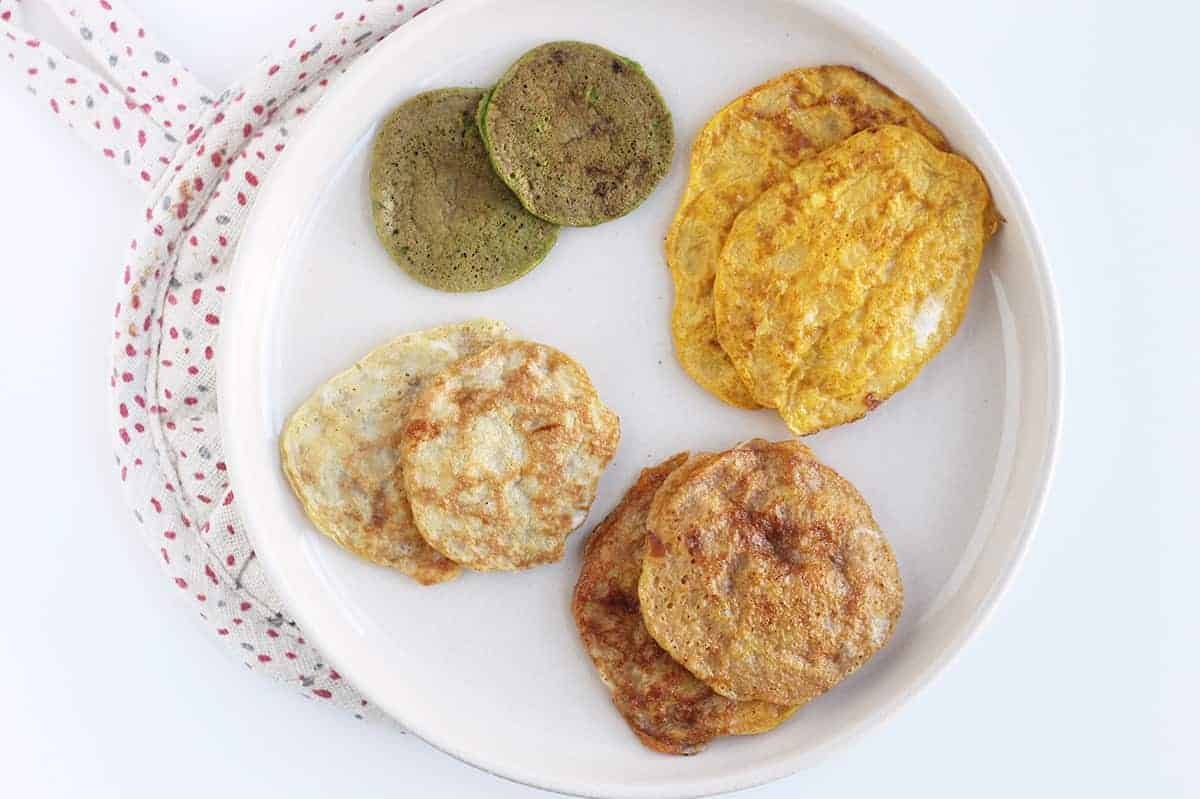
I love recipes for kids that use simple ingredients and are also SUPER quick and easy to make and this method for making 2-ingredient baby pancakes totally fits that bill. You just need to stir together the ingredients with a fork to make the simple pancake batter, then cook, and a few minutes later, voila, you have nutritious pancakes for kids.
The texture of these baby pancakes for kids is very moist, which makes them a perfect first food for babies—if using the baby-led weaning style of feeding. Or as an early baby finger food. Simply give them a pancake to gnaw and suck on—or cut up into small pieces for a baby who’s able to grasp finger foods.
They are also great as a 1-year-old recipe who may still be learning to chew more bread-like textures. (These sort of melt in the mouth, like custard! Plus, you can make them ahead and serve them as needed—which is great if you want fast meal options for at home or packing toddler lunches for daycare or preschool throughout the week.
The method for this baby pancake recipe starts with a base of banana and egg, then you have the option to try it with sweet potato, pumpkin, and spinach. Each flavor is easy and offers a range of nutrients for the kids.
(You may also like Baby-Led Weaning Breakfasts, easy baby meals, and Sweet Potato Baby Food.)
Table of Contents
Your toddler won’t eat? Help is here!
Sign up for our email updates to get tips and ideas sent to your inbox.
Ingredients You Need
The ingredients you need for this baby pancake recipe are very simple. You need to have the following items on hand and ready go to.
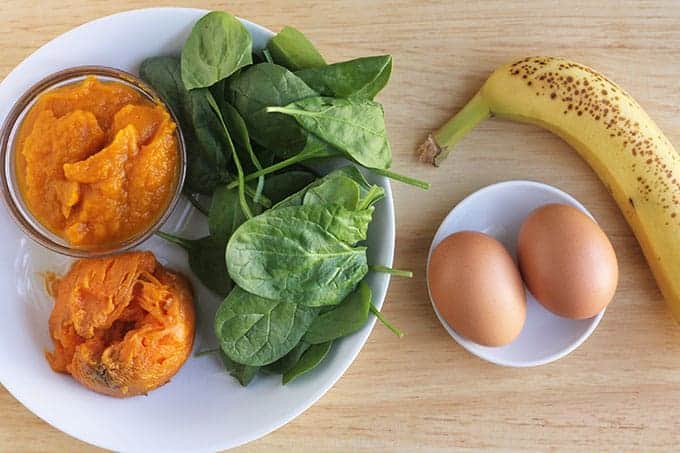
- Egg: I use large eggs here, which help bind the batter together and add nutrients including protein and beneficial fats.
- Banana: The riper the banana, the better the flavor so make sure there is some brown spots on your fruit.
- Optional: You can add a little baking soda for a little extra fluff, and/or cinnamon and vanilla extract for more flavor if desired.
Ingredient Substitutions
If you want to try a different flavor of baby pancakes, you can use mashed roasted sweet potato baby food or pumpkin baby food as the base in place of banana.
You can also blend spinach into any base to add an iron-rich food for kids.
Step-by-Step Instructions
Here’s a look at the simple process involved in making the baby pancakes so you know what to expect. See the full information at the bottom of the post, including the amounts and the timing.

Step 1. Mash the banana with a fork or a potato masher. (You can also use a blender.)

Step 2. Mix with the egg to make a uniform batter.

Step 3. Cook one small pancake at a time in a nonstick pan, similarly to how you’d cook any other pancake.

Step 4. Flip over each baby pancake carefully and cook through. Serve warm.
TIP: These baby pancakes are delicate and custard-like, so be gentle when flipping them over. It may take a pancake or two to get the hang of the process. See the recipe below for all of the flavor variations.
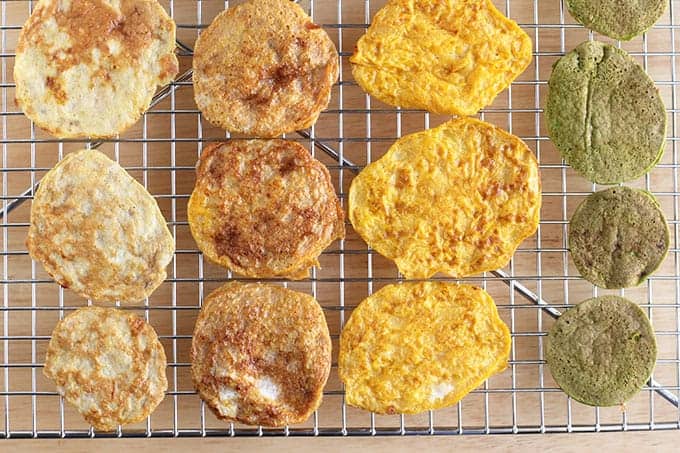
Frequently Asked Questions
You can serve these with yogurt or applesauce for dipping. We sometimes even do them with warmed frozen blueberries—the warm fruit will have a flavorful liquid that’s yummy for dipping. We usually like to have some fruit on the side.
Yes, babies can eat pancakes if they are moist enough. These baby pancakes are an easy option as a starter pancake for kids since they are incredibly moist and easy to chew.
Yes, you can serve one of these pancakes whole for them to take bites, or you can dice it up if baby is able to pick up small pieces of food.
You can offer baby one of these banana pancakes (or another flavor) as a baby-led weaning food of feeding. You’d give them a whole pancake and let them suck on and eat the pancake on their own.
These are a perfect pancake for babies since they are so soft and easy to chew, even if your baby doesn’t yet have any teeth.
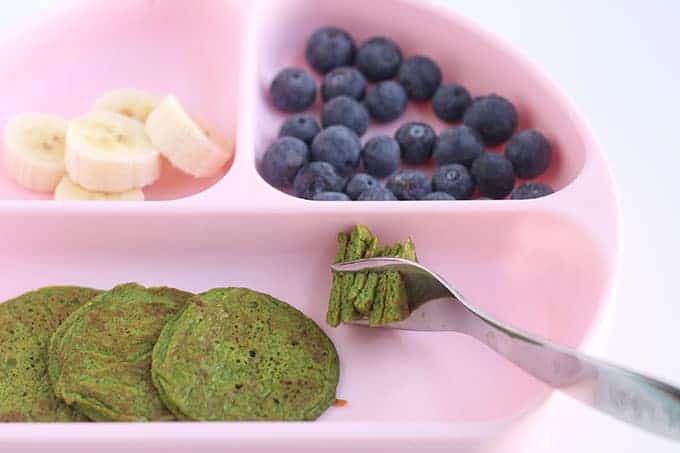
How to Store
To store, let baby pancakes cool fully on a wire rack. Store in an airtight container in the fridge for up to 3 days. Reheat briefly to serve. Or, freeze them either in a single layer in a gallon-size storage bag or with parchment paper between each pancake in a stack in a storage bag.
Heat as many as needed on a plate very briefly, and serve.
Best Tips for Success
- It may take a pancake or two to get the hang of the process—these are delicate pancakes with a texture that’s sort of custardy like French toast, so be gentle when flipping them. I broke a few the first time I made them!
- Add ⅛ teaspoon baking soda for fluffier baby pancakes.
- Add ¼ teaspoon cinnamon or pure vanilla extract for additional flavor.
- Sweet Potato Baby Pancakes: Use mashed roasted sweet potato baby food instead of the banana and proceed with the recipe
- Spinach Banana Baby Pancakes: Place the banana (or sweet potato) and egg into a blender. Add a handful of lightly packed baby spinach. Blend well, then proceed with the recipe.
- Pumpkin Baby Pancakes: Use pumpkin baby food instead of the banana and proceed with the recipe. This baby pancake batter will be thinner than the banana or sweet potato flavors.
- Try with Baked Sliced Apples or Baked Pears.
Related Recipes
Recipes
Favorite Yogurt Pancakes
Breakfast
Banana Spinach Pancakes
Breakfast
Favorite Sweet Potato Pancakes
Breakfast
3-Ingredient Banana Pancakes
Please leave a comment to let me know what you think of the recipe if you try it. I love to hear what your kids think of my recipes!
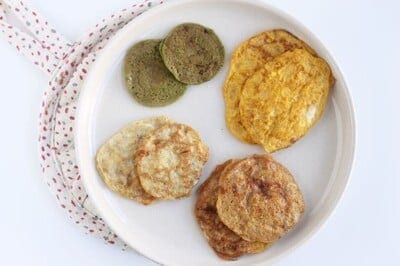
Best 2-Ingredient Baby Pancakes
Ingredients
- ¼ cup mashed very ripe banana (about 1 small)
- 1 egg
- ⅛ teaspoon baking soda (optional)
- Butter or oil, for cooking
- Toppings including applesauce, yogurt, and/or diced fruit
Instructions
- Place a nonstick or cast iron skillet or griddle over medium heat. (I prefer nonstick.) Add a small slice of butter or oil.
- Mash the banana with a fork in a medium bowl. Crack the eggs into the same bowl and stir together. The batter will be very runny.
- Spread the butter or oil with a spatula to coat the bottom of the pan. Place 1 tablespoon batter into the pan to make small pancakes. Cook until the edges start to set and the bottoms are lightly browned, about 1 minute.
- Flip carefully and cook for an additional minute. (These are delicate so try to get your spatula halfway under the pancake, then carefully turn over.)
- Remove from pan—the pancakes will be very soft and tender—and serve with any desired toppings.
Video
Notes
- To store, let pancakes cool fully on a wire rack. Store in an airtight container in the fridge for up to 3 days. Reheat briefly to serve. Or, freeze them either in a single layer in a gallon-size storage bag or with parchment paper between each pancake in a stack in a storage bag. Heat as many as needed on a plate and serve.
- This recipe makes one small batch of super baby pancakes. It usually makes 1-2 little-kid-size servings. To make more, simply double the recipe.
- Sweet Potato Pancakes: Use ¼ cup mashed roasted sweet potato instead of the banana and proceed with the recipe.
- Spinach Banana Pancakes: Place the banana (or sweet potato) and egg into a blender. Add a handful of lightly packed baby spinach. Blend well, then proceed with the recipe.
- Pumpkin Pancakes: Use ¼ cup pumpkin puree instead of the banana and proceed with the recipe. This batter will be thinner than the banana or sweet potato flavors.
- It may take a pancake or two to get the hang of the process—these are delicate pancakes with a texture that’s sort of custardy like French toast, so be gentle when flipping them. I broke a few the first time I made them!
- Add ⅛ teaspoon baking soda for fluffier pancakes.
- Add ¼ teaspoon cinnamon or pure vanilla extract for additional flavor.
Nutrition
This post was first published in May 2020.
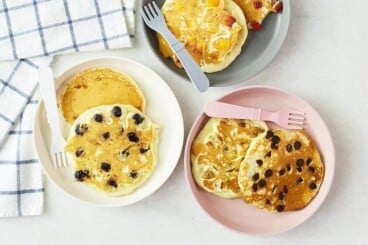
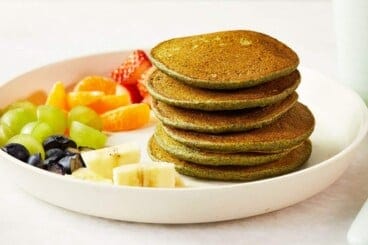
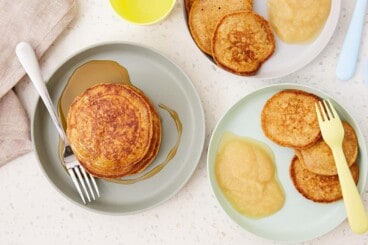
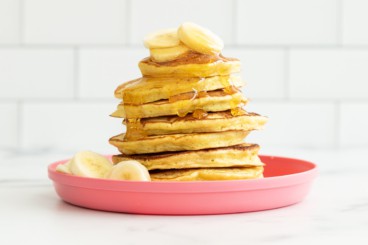


















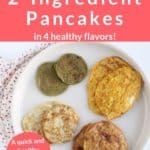
Amy, I just wanted to mention I love how you add vegetables and fruits into almost everything you cook or at least your recipes that you put here. I have enjoyed the idea and have made many of your recipes. My 11 month old really enjoyed these pancakes. I only made the spinach and banana and Sweet potato options but he favors the spinach and banana even though he likes sweet potato steamed. He really liked the consistency I am shocked! Thank you, Amy for so many great ideas!
I am so happy to hear that! Thanks!
You’re so welcome and thank you for taking the time to leave a comment!
These are my toddler’s favorite pancakes! I make them any time our bananas get overripe. Using the blender instead of mashing the bananas by hand gives a much better texture, so I prefer that method.
Thank you! Would this work with butternut squash purée?
Sure!
How long can these stay in the freezer and remain good? Would they have the same shelf life as the banana spinach muffins, about 3 months?
3-6 months if they are either wrapped well or in a freezer bag with as much air removed as possible before sealing.